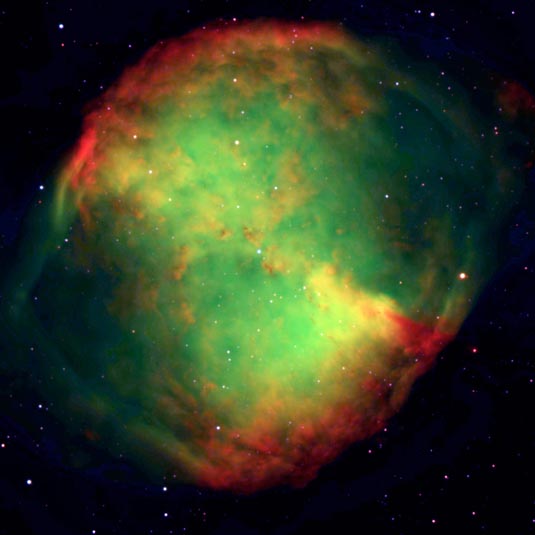
Planetary Nebula
RA 19h 59m 36.3s Dec +22° 43? 16.1?
Vulpecula
1200 light years
7.5
8?.0 × 5?.6
September 28, 1998
ESO
October 7, 1998
Related image: N1111
ABOUT THIS IMAGE:
The Dumbbell Nebula - also known as Messier 27 or NGC 6853 - is a typical planetary nebula and is located in the constellation Vulpecula (The Fox). The distance is rather uncertain, but is believed to be around 1,200 light-years. It was first described by the French astronomer and comet hunter Charles Messier who found it in 1764 and included it as no. 27 in his famous list of extended sky objects. Despite its class, the Dumbbell Nebula has nothing to do with planets. It consists of very rarified gas that has been ejected from the hot central star (well visible on this photo), now in one of the last evolutionary stages. The gas atoms in the nebula are excited (heated) by the intense ultraviolet radiation from this star and emit strongly at specific wavelengths.
This image is the beautiful by-product of a technical test of some FORS1 narrow-band optical interference filtres. They only allow light in a small wavelength range to pass and are used to isolate emissions from particular atoms and ions. In this three-colour composite, a short exposure was first made through a wide-band filter registering blue light from the nebula. It was then combined with exposures through two interference filtres in the light of double-ionized oxygen atoms and atomic hydrogen. They were colour-coded as "blue", "green" and "red", respectively, and then combined to produce this picture that shows the structure of the nebula in "approximately true" colours.
They are three-colour composite based on two interference ([OIII] at 501 nm and 6 nm FWHM - 5 min exposure time; H-alpha at 656 nm and 6 nm FWHM - 5 min) and one broadband (Bessell B at 429 nm and 88 nm FWHM; 30 sec) filtre images, obtained on September 28, 1998, during mediocre seeing conditions (0.8 arcsec). The CCD camera has 2048 x 2048 pix, each covering 24 x 24 µm and the sky fields shown measure 6.8 x 6.8 arcmin and 3.5 x 3.9 arcmin, respectively. North is up; East is left.